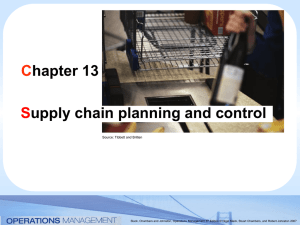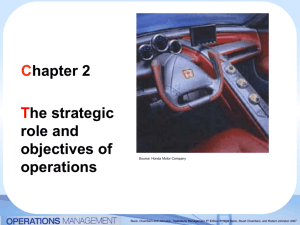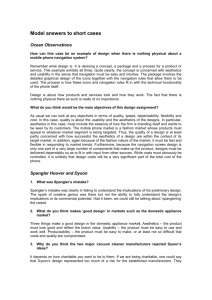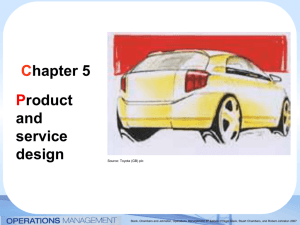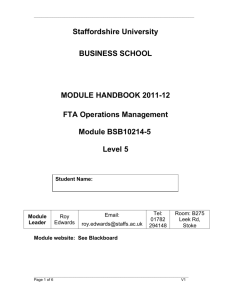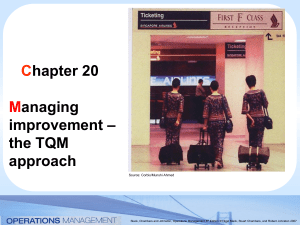Chapter 15 Powerpoint slides
advertisement
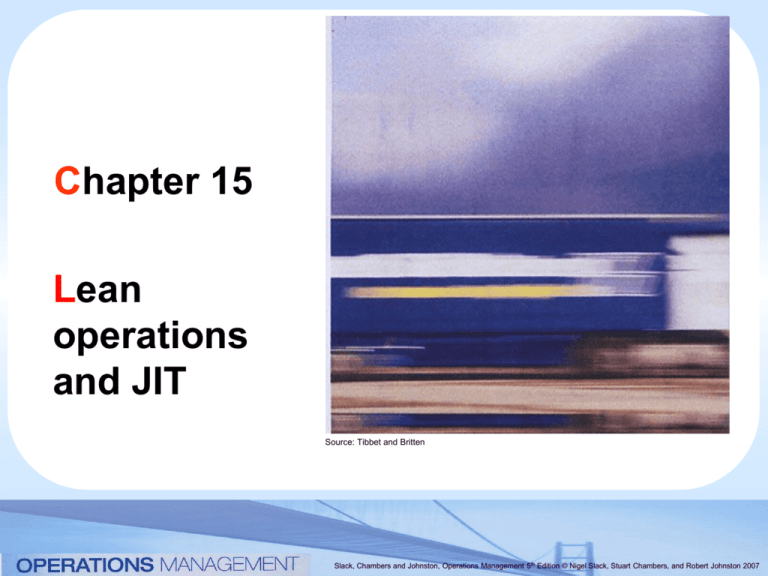
Chapter 15 Lean operations and JIT Source: Tibbet and Britten Slack, Chambers and Johnston, Operations Management 5th Edition © Nigel Slack, Stuart Chambers, and Robert Johnston 2007 Lean operations and JIT Operations strategy Lean operations and JIT The market requires … specified time, quantity and quality of products and services The operation supplies … the delivery of products and services only when needed Design Operations management Improvement Planning and control Slack, Chambers and Johnston, Operations Management 5th Edition © Nigel Slack, Stuart Chambers, and Robert Johnston 2007 ‘The key principle of lean operations is relatively straightforward to understand: it means moving towards the elimination of all waste in order to develop an operation that is faster and more dependable, produces higher quality products and services and, above all, operates at low cost.’ Slack, Chambers and Johnston, Operations Management 5th Edition © Nigel Slack, Stuart Chambers, and Robert Johnston 2007 Synonyms continuous flow manufacture high value-added manufacture stockless production low-inventory production fast-throughput manufacturing lean manufacturing Toyota production system short cycle time manufacturing Source: Corbis/Denis Balihouse Slack, Chambers and Johnston, Operations Management 5th Edition © Nigel Slack, Stuart Chambers, and Robert Johnston 2007 JIT material flow Traditional approach stage A buffer inventory stage B buffer inventory stage C JIT approach orders orders stage B stage A deliveries stage C deliveries Slack, Chambers and Johnston, Operations Management 5th Edition © Nigel Slack, Stuart Chambers, and Robert Johnston 2007 JIT and capacity utilization Traditional approach focus on producing only when needed JIT approach fewer stoppages focus on high capacity utilization lower capacity utilization, but more stoppages because of problems more production at each stage high inventory means less chance of problems being exposed and solved extra production goes into inventory because of continuing stoppages at stages low inventory so problems are exposed and solved no surplus production goes into inventory Slack, Chambers and Johnston, Operations Management 5th Edition © Nigel Slack, Stuart Chambers, and Robert Johnston 2007 JIT definitions JIT aims to meet demand instantly, with perfect quality and no waste More fully: Improved overall productivity and elimination of waste Cost-effective production and delivery of only the necessary quantity of parts at the right quality, at the right time and place, while using a minimum amount of facilities, equipment, materials and human resources JIT is dependent on the balance between the supplier’s flexibility and the user’s flexibility JIT is accomplished through the application of elements that require total employee involvement and teamwork Source: Empics A key philosophy of JIT is simplification Slack, Chambers and Johnston, Operations Management 5th Edition © Nigel Slack, Stuart Chambers, and Robert Johnston 2007 The lean philosophy of operations is the basis for JIT techniques that include JIT methods of planning and control The lean philosophy of operations Eliminate waste Involve everyone Continuous improvement JIT as a set of techniques for managing operations Basic working practices TPM Design for manufacture Set-up reduction Operations focus Total people involvement Small, simple machines Visibility Flow layout JIT supply JIT as a method of planning and control Pull scheduling ‘Kanban’ control Levelled scheduling Mixed modelling Synchronization Slack, Chambers and Johnston, Operations Management 5th Edition © Nigel Slack, Stuart Chambers, and Robert Johnston 2007 The 5 S’s Sort (Seiri) Eliminate what is not needed and keep what is needed. Straighten (Seiton) Position things in such a way that they can be easily reached whenever they are needed. Shine (Seiso) Keep things clean and tidy; no refuse or dirt in the work area. Standardize (Seiketsu) Maintain cleanliness and order – perpetual neatness. Sustain (Shitsuke) Develop a commitment and pride in keeping to standards. Slack, Chambers and Johnston, Operations Management 5th Edition © Nigel Slack, Stuart Chambers, and Robert Johnston 2007 Delivering smaller quantities more often can reduce inventory levels Inventory level Inventory level Slack, Chambers and Johnston, Operations Management 5th Edition © Nigel Slack, Stuart Chambers, and Robert Johnston 2007 Waste (muda) Activities: operation movement Which of these symbols signify non-valueadding activities? Types of waste: over-production waiting time transport inspection process inventory delay storage motion defective goods influencing the throughput efficiency Slack, Chambers and Johnston, Operations Management 5th Edition © Nigel Slack, Stuart Chambers, and Robert Johnston 2007 The problem with inventory productivity problems Reduce the level of inventory (water) to reveal the operations’ problems WIP Defective materials Scrap Rework Downtime WIP Defective materials productivity problems Scrap Rework Downtime Slack, Chambers and Johnston, Operations Management 5th Edition © Nigel Slack, Stuart Chambers, and Robert Johnston 2007 Small machines The conventional Western approach is to purchase large machines to get ‘economies of scale’. These often have long, complex set-ups, and make big batches, quickly creating ‘waste’. Slack, Chambers and Johnston, Operations Management 5th Edition © Nigel Slack, Stuart Chambers, and Robert Johnston 2007 Using several small machines rather than one large one allows simultaneous processing, is more robust and is more flexible JIT small machines approach: easy to move (layout) quick set-up flexible scheduling options cheaper tooling planned maintenance easier fewer set-ups needed emphasis: flexibility economies of scope Slack, Chambers and Johnston, Operations Management 5th Edition © Nigel Slack, Stuart Chambers, and Robert Johnston 2007 Visible, enforced improvement ‘Traditional’ production systems often accept waste and use the insurance of all types of inventory In JIT systems: gradual reduction of inventory identify exposed problems eliminate these problems repeat the cycle emphasis: continuous improvement in small steps, to expose waste and eliminate it Slack, Chambers and Johnston, Operations Management 5th Edition © Nigel Slack, Stuart Chambers, and Robert Johnston 2007 JIT, MRP, or both? complex structures PERT MRP JIT and/or MRP simple structures JIT simple routings complex routings Slack, Chambers and Johnston, Operations Management 5th Edition © Nigel Slack, Stuart Chambers, and Robert Johnston 2007 Key Terms Test Just-in-time (JIT) A method of planning and control and an operations philosophy that aims to meet demand instantaneously with perfect quality and no waste. Kaizen Japanese term for continuous improvement. Set-up reduction The process of reducing the time taken to change over a process from one activity to the next; also called single minute exchange of dies (SMED) after its origins in the metal pressing industry. Slack, Chambers and Johnston, Operations Management 5th Edition © Nigel Slack, Stuart Chambers, and Robert Johnston 2007 Key Terms Test Single minute exchange of dies (SMED) Alternative term for set-up reduction. Andon A light above a workstation that indicates its state: whether working, waiting for work, broken down, etc. Andon lights may be used to stop the whole line when one station stops. Slack, Chambers and Johnston, Operations Management 5th Edition © Nigel Slack, Stuart Chambers, and Robert Johnston 2007 Key Terms Test Kanban Japanese term for card or signal; it is a simple controlling device that is used to authorize the release of materials in pull control systems such as those used in JIT. Levelled scheduling (Heijunka) The idea that the mix and volume of activity should even out over time so as to make output routine and regular, sometimes known by the Japanese term ‘heijunka’. Slack, Chambers and Johnston, Operations Management 5th Edition © Nigel Slack, Stuart Chambers, and Robert Johnston 2007
